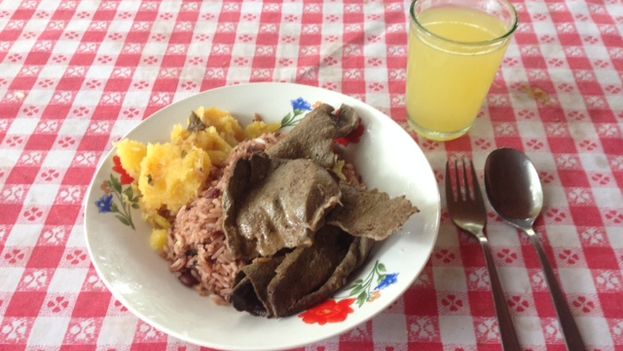
![]() 14ymedio, Reinaldo Escobar, Havana, 29 January 2016 – “Give me the full meal,” a man tells the waiter who has stopped for a second at the table with the menu. No need to specify the menu item, the amounts or how you want it. The phrase “full meal” says it all: a plate with rice, some meat, a little vegetable and perhaps a salad. Service is fast, there are no details or sauces to choose from, just a little bit of everything before the infinite appetite of the diner.
14ymedio, Reinaldo Escobar, Havana, 29 January 2016 – “Give me the full meal,” a man tells the waiter who has stopped for a second at the table with the menu. No need to specify the menu item, the amounts or how you want it. The phrase “full meal” says it all: a plate with rice, some meat, a little vegetable and perhaps a salad. Service is fast, there are no details or sauces to choose from, just a little bit of everything before the infinite appetite of the diner.
The practice of eating away from home spread through many societies, where the family table was no longer featured when it came time to eat. The requirements of work and the speed of modern life have made people in many parts of the world choose to eat breakfast, lunch and dinner out.
In Cuba, those who go out to eat “on the street” know that they will need more money than they earn in a day’s work. There is no need to call out extreme examples of private or state restaurants where the average price for one person varies between 10 and 15 Cuban convertible pesos (about $11 to $17 U.S.), a figure that can double if the most expensive items on the menu are requested.
Among the most affordable options is food that is digested without even sitting down, which can be “bread with something” or a pizza costing ten Cuban pesos (about 40¢ US) that comes wrapped in paper and dripping with cheese. There are also the little cartons in Havana’s Chinatown where for 25 or 35 Cuban pesos you can “calm the dog,” meaning the stomach.
Other sites have managed to position themselves in a zone between the private and the state, like certain private restaurants attached to the agricultural markets. El Ranchón at the Youth Labor Army (EJT) market on Tulipan Street is a restaurant that enjoys a certain permissiveness and whose owner, as discussed in the neighborhood, is a member of the armed forces.
In places like this, of which there are very few in the city, they serve a plate with rice and beans, salad, mashed sweet potato and pork liver steak for 20 Cuban pesos. With the same sides, other options for the main course include roast pork, lamb fricassee or fried chicken, but the price never exceeds 40 Cuban pesos, even if fruit juice is included. There are no flowers or candles on the table and you have to cut the meat with a spoon, because there are no knives, but it’s good.
On the periphery of Ranchón are two government ministries, three banks, a high school and three military units, in addition to the thousands of customers who visit the busy market daily. A very old man with an enormous appetite asks for the leftovers every day. He hides so they don’t see him. He must be over 80 and he says that in his youth he could get “a full meal” for 25 centavos anywhere, “with beef: shredded, steak, or ground.”
Now that workplace cafeterias have almost disappeared, many people bring their full meal in a plastic bag and others who have chosen to eat just one meal a day, that they eagerly devour when they get home.
